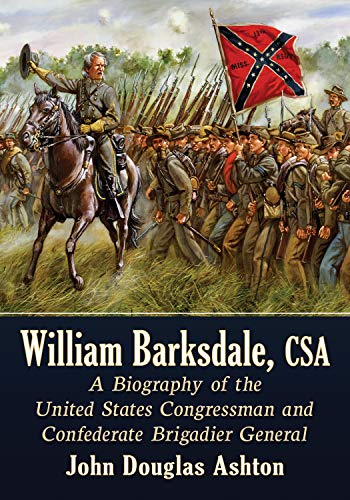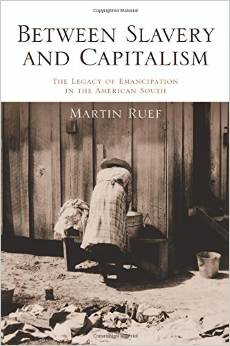William Barksdale’s life is often reduced to a single episode—namely, the charge his brigade made at Gettysburg on July 2, 1863. This tendency leaves most of Barksdale’s life unexamined. As author John Douglas Ashton contends, Barksdale’s “life story is compelling and deserves to be told, with a complete account of his political and military careers, his accomplishments and his historical legacy” (3). This cradle-to-grave biography of Barksdale contains some interesting information, but also suffers from some shortcomings.
As a young man, William Barksdale and his brothers went to Mississippi in search of opportunities. This proved to be a consequential decision, especially considering Barksdale’s relationship with another transplanted Mississippian, Jefferson Davis. Barksdale served during the U.S. War with Mexico and, after the war ended, returned to Mississippi to become a candidate for Congress in 1853. Barksdale won election to the U.S. House of Representatives, where he served until his resignation in 1861.
Ashton includes two chapters on Barksdale’s time in Congress. Some of the material in these chapters suggests that Ashton may have become overly enamored with his subject. This is not necessarily surprising. One of the major pitfalls of writing biography is falling in love with one’s subject. However, taking this approach to the subject of the book often leads to inaccurate analysis. For example, of Barksdale’s first speech in the House, Ashton writes, “Barksdale had certainly made an indelible impression on his colleagues” (44). Ashton does not cite anything to back up this statement. More problematically, Ashton argues that the First Session of the 34th Congress “will be remembered for three occurrences—an acrimonious, partisan, nine-week ordeal to elect a Speaker of the House, the brutal caning of Massachusetts Senator Charles Sumner in the Senate Chamber by South Carolina Congressman Preston Brooks, and Barksdale’s hour-long address concerning the critical nature of the upcoming presidential election of 1856” (46-47). Scholars have indeed long noted the paramount importance of the fight over the Speakership and the caning of Sumner. That said, to place Barksdale’s speech alongside these events and claim it was of equal importance is misguided.
Some scholars have argued that Barksdale participated in the attack on Sumner. However, as Ashton contends, Barksdale did not. This is a good point to remember, but Ashton’s comment that “this untruth has done a great disservice to the reputation of an honorable man” (52) is troubling. Is committing treason honorable? Ashton’s use of “Black Republican” without quotes (52) is also problematic. His repeated insistence that slavery was an “issue (not the root cause)” (18) of the U.S. Civil War is likewise disconcerting.
The balance of the book examines Barksdale’s experiences during the U.S. Civil War and how he has been remembered. His service to the Confederacy began as the Quartermaster General of the Army of Mississippi. Shortly thereafter, Barksdale became Colonel of the 13th Mississippi. Ashton contends, correctly, that, following the Battle of First Manassas, Barksdale’s career was off to a promising start. However, on a march to Leesburg, Barksdale became intoxicated and verbally abused his men. This resulted in his being put under arrest; most of the officers in the regiment tendered their resignations. What might have ended someone else’s career did not end Barksdale’s because of his close friendship with Jefferson Davis. Ashton does not believe Davis interfered to help Barksdale. That said, in delaying the court of inquiry, Davis played for time and gave Barksdale a chance to curry favor with his men through a successful performance in battle.
Ashton guides readers through some of the famous engagements in which Barksdale participated. Barksdale showed that he was a “born leader of men” (128) at Malvern Hill. He performed well at Harpers Ferry and at Antietam. Ashton approvingly quotes historian Robert K. Krick that Barksdale was “that surprisingly rare creature, a fire-eating politician both willing and able to serve with distinction in the field” (148). Fredericksburg also became an important moment for Barksdale because he contested the U.S. attempts to cross via pontoon bridges. Ashton argues that Barksdale’s time at Fredericksburg was “a brilliant defensive performance unique in the annals of American military history up to that time” (174) and that “Barksdale’s leadership on the defensive had been nothing short of phenomenal” (175). Ashton tends to overlook or minimize the advantages Barksdale had while on the defensive. Barksdale’s performance during the Chancellorsville campaign was a definite blemish on his record. Ashton also unpacks Barksdale’s subsequent war of words with the irascible Jubal Early over who was responsible.
The Gettysburg Campaign, specifically Barksdale’s charge at Gettysburg, serves as the climax of the book. Troublingly, despite his condemnation of the “devilish work of sack and plunder” by U.S. soldiers at Fredericksburg (171), Ashton grossly downplays rebel depredations as the Army of Northern Virginia moved north into Pennsylvania. He also says nothing about the free Black people Lee’s army kidnapped and sent south into slavery. Barksdale no doubt fully supported kidnapping and selling free Black people in Pennsylvania into slavery.
Ashton analyzes the destruction of Thaddeus Stevens’s ironworks in some detail. Despite Barksdale’s “strong sense of fairness and capacity for forgiveness, it is not difficult to conclude that the wanton destruction of Stevens’ treasured foundry and the accompanying deep financial loss inflicted on this despised Black Republican abolitionist, would have elicited a strong sense of satisfaction and vindication within William Barksdale” (209). The author is undoubtedly correct that Barksdale was satisfied by the destruction of the ironworks. Barksdale and Stevens, it is worth remembering, served together in the U.S. Congress. At one point during their time in Washington, Barksdale “unsheathed his bowie knife and lunged at Stevens” (68). Luckily, Ashton observes, “Stevens’ friends intervened to quell the altercation” (68). Ashton does not dwell on the fact that Barksdale came extremely close to adding the murder of Stevens to a long list of outrages committed by the Slave Power. The destruction of the ironworks, then, seems perfectly in keeping with Barksdale’s disreputable actions.
For those interested in Barksdale’s charge on Gettysburg’s second day, Ashton gives a pretty good overview. He likewise supplies an account of Barksdale’s death, burial, and funeral. “In the final analysis,” Ashton comments, “William Barksdale typically reflected the social and moral values and political views of his Southern heritage” (255).
Anyone interested in learning more about Barksdale’s military career will find some useful information but, as this review has explained, some of the book’s shortcomings in analysis and interpretation require readers to exercise care.
Evan C. Rothera is Assistant Professor of History at the University of Arkansas—Fort Smith. He is the author of an article on William Barksdale in history and memory.
Related topics: Confederacy





